Knowledge Mapping of the Extant Literature on the Environmental Impacts of Using Cover Crops—A Scientometric Study
Abstract
:1. Introduction
Purpose of the Study and Contribution to the Literature
2. Methods
2.1. Data Collection
2.2. Research Design and Analysis
3. Results and Discussion
3.1. Distribution of Publications over the Years and Cited Journals
3.2. Co-Citation Analysis
3.3. Citation-Clustering Analysis
3.4. Co-Occurrence Network of Subject Terms Analysis
3.5. Academic Cooperation among Authors, Institutions, and Countries
3.5.1. Co-Authorship Network Analysis
3.5.2. Institution and Country Collaboration Network Analyses
4. Conclusions
Limitations and Future Scientometric Research
Author Contributions
Funding
Data Availability Statement
Acknowledgments
Conflicts of Interest
Appendix A
Network Analysis Indicators
References
- Jiang, Y.; Li, S.; Chen, W.; Cai, D.; Liu, Y. The Evolution of Crop Cultivation and Paleoenvironment in the Longji Terraces, Southern China: Organic Geochemical Evidence from Paleosols. J. Environ. Manag. 2017, 202, 524–531. [Google Scholar] [CrossRef] [PubMed]
- King, F.H. Farmers of Forty Centuries: Organic Farming in China, Korea, and Japan, Later ed.; Dover Publications: Mineola, NY, UAS, 2004; ISBN 978-0-486-43609-8. [Google Scholar]
- Groff, S. The Past, Present, and Future of the Cover Crop Industry. J. Soil Water Conserv. 2015, 70, 130A–133A. [Google Scholar] [CrossRef]
- Hu, Q.; Torres-Alavez, J.A.; Broeke, M.S.V.D. Land-Cover Change and the “Dust Bowl” Drought in the U.S. Great Plains. J. Clim. 2018, 31, 4657–4667. [Google Scholar] [CrossRef]
- Sauter, S. Australia’s Dust Bowl: Transnational Influences in Soil Conservation and the Spread of Ecological Thought. Aust. J. Polit. Hist. 2015, 61, 352–365. [Google Scholar] [CrossRef]
- Magdoff, F.; van Es, H. Building Soils for Better Crops: Organic Matter Management. Soil Sci. 1993, 156, 371. [Google Scholar] [CrossRef]
- Hamilton, N.D. Eight Steps to Understanding the Evolution of Sustainable Agriculture in the United States Essay. Drake J. Agric. Law 2019, 24, 67–74. [Google Scholar]
- Laforge, J.M.L.; Levkoe, C.Z. Seeding Agroecology through New Farmer Training in Canada: Knowledge, Practice, and Relational Identities. Local Environ. 2018, 23, 991–1007. [Google Scholar] [CrossRef]
- Acevedo-Osorio, Á.; Chohan, J.K. Agroecology as Social Movement and Practice in Cabrera’s Peasant Reserve Zone, Colombia. Agroecol. Sustain. Food Syst. 2020, 44, 331–351. [Google Scholar] [CrossRef]
- Kansanga, M.M.; Luginaah, I.; Bezner Kerr, R.; Lupafya, E.; Dakishoni, L. Beyond Ecological Synergies: Examining the Impact of Participatory Agroecology on Social Capital in Smallholder Farming Communities. Int. J. Sustain. Dev. World Ecol. 2020, 27, 1–14. [Google Scholar] [CrossRef]
- Mdee, A.; Wostry, A.; Coulson, A.; Maro, J. A Pathway to Inclusive Sustainable Intensification in Agriculture? Assessing Evidence on the Application of Agroecology in Tanzania. Agroecol. Sustain. Food Syst. 2019, 43, 201–227. [Google Scholar] [CrossRef]
- Corina Paula, N. Urban Agroecology in Campo Grande, Brazil. Ann. Univ. Oradea Geogr. Ser. 2019, 29, 19–29. [Google Scholar] [CrossRef]
- SARE Cover Crops for Sustainable Crop Rotations. Available online: https://www.sare.org/resources/cover-crops/ (accessed on 26 August 2022).
- SARE National Farmer Survey Documents a Wide Range of Cover Crop Benefits as Acreage Continues to Expand. Available online: https://www.sare.org/news/2020-cover-crop-survey-report/ (accessed on 26 August 2022).
- USDA ARS Cover Crop Chart. Available online: https://www.ars.usda.gov/plains-area/mandan-nd/ngprl/docs/cover-crop-chart/ (accessed on 26 August 2022).
- USDA ERS Cover Crop Trends, Programs, and Practices in the United States. Available online: http://www.ers.usda.gov/publications/pub-details/?pubid=100550 (accessed on 26 August 2022).
- The Organic Foods Production Act of 1990 (OFPA), Provisions of the Food, Agriculture, Conservation, and Trade Act of 1990. Available online: https://www.ers.usda.gov/webdocs/publications/42024/50891_aib624a.pdf?v=5337 (accessed on 26 August 2022).
- National Organic Program (NOP), Part IV: Rules and Regulations. Available online: https://www.govinfo.gov/app/details/FR-2000-12-21/00-32257 (accessed on 26 August 2022).
- Council Regulation (EEC) No 2092/91 of 24 June 1991 on Organic Production of Agricultural Products and Indications Referring Thereto on Agricultural Products and Foodstuffs,1991. Available online: http://extwprlegs1.fao.org/docs/pdf/eur2355.pdf (accessed on 26 August 2022).
- Council Regulation (EEC) No 2078/92 of 30 June 1992 on Agricultural Production Methods Compatible with the Requirements of the Protection of the Environment and the Maintenance of the Countryside, 1997. Available online: http://aei.pitt.edu/6215/1/6215.pdf (accessed on 26 August 2022).
- Council Regulation (EEC) No 1804/1999 of 19 July 1999 Supplementing Regulation (EEC) No 2092/91 on Organic Production of Agricultural Products and Indications Referring Thereto on Agricultural Products and Foodstuffs to Include Livestock Production, CELEX1; Publications Office of the European Union, 1999. Available online: https://eur-lex.europa.eu/LexUriServ/LexUriServ.do?uri=CONSLEG:1991R2092:20060506:EN:PDF (accessed on 26 August 2022).
- Chen, C. CiteSpace II: Detecting and Visualizing Emerging Trends and Transient Patterns in Scientific Literature. J. Am. Soc. Inf. Sci. Technol. 2006, 57, 359–377. [Google Scholar] [CrossRef]
- Lee, W. How to Identify Emerging Research Fields Using Scientometrics: An Example in the Field of Information Security. Scientometrics 2008, 76, 503–525. [Google Scholar] [CrossRef]
- Zhang, L.; Yan, C.; Guo, Q.; Zhang, J.; Ruiz-Menjivar, J. The Impact of Agricultural Chemical Inputs on Environment: Global Evidence from Informetrics Analysis and Visualization. Int. J. Low-Carbon Technol. 2018, 13, 338–352. [Google Scholar] [CrossRef]
- Blanco-Canqui, H.; Ruis, S.J. Cover Crop Impacts on Soil Physical Properties: A Review. Soil Sci. Soc. Am. J. 2020, 84, 1527–1576. [Google Scholar] [CrossRef]
- Haruna, S.I.; Anderson, S.H.; Udawatta, R.P.; Gantzer, C.J.; Phillips, N.C.; Cui, S.; Gao, Y. Improving Soil Physical Properties through the Use of Cover Crops: A Review. Agrosystems Geosci. Environ. 2020, 3, e20105. [Google Scholar] [CrossRef]
- Adetunji, A.T.; Ncube, B.; Mulidzi, R.; Lewu, F.B. Management Impact and Benefit of Cover Crops on Soil Quality: A Review. Soil Tillage Res. 2020, 204, 104717. [Google Scholar] [CrossRef]
- Bolinder, M.A.; Crotty, F.; Elsen, A.; Frac, M.; Kismányoky, T.; Lipiec, J.; Tits, M.; Tóth, Z.; Kätterer, T. The Effect of Crop Residues, Cover Crops, Manures and Nitrogen Fertilization on Soil Organic Carbon Changes in Agroecosystems: A Synthesis of Reviews. Mitig. Adapt. Strateg. Glob. Change 2020, 25, 929–952. [Google Scholar] [CrossRef]
- Bergtold, J.S.; Ramsey, S.; Maddy, L.; Williams, J.R. A Review of Economic Considerations for Cover Crops as a Conservation Practice. Renew. Agric. Food Syst. 2019, 34, 62–76. [Google Scholar] [CrossRef]
- Thapa, R.; Mirsky, S.B.; Tully, K.L. Cover Crops Reduce Nitrate Leaching in Agroecosystems:A Global Meta-Analysis. J. Environ. Qual. 2018, 47, 1400–1411. [Google Scholar] [CrossRef]
- Osipitan, O.A.; Dille, J.A.; Assefa, Y.; Knezevic, S.Z. Cover Crop for Early Season Weed Suppression in Crops: Systematic Review and Meta-Analysis. Agron. J. 2018, 110, 2211–2221. [Google Scholar] [CrossRef] [Green Version]
- Bowles, T.M.; Jackson, L.E.; Loeher, M.; Cavagnaro, T.R. Ecological Intensification and Arbuscular Mycorrhizas: A Meta-Analysis of Tillage and Cover Crop Effects. J. Appl. Ecol. 2017, 54, 1785–1793. [Google Scholar] [CrossRef]
- Alvarez, R.; Steinbach, H.S.; De Paepe, J.L. Cover Crop Effects on Soils and Subsequent Crops in the Pampas: A Meta-Analysis. Soil Tillage Res. 2017, 170, 53–65. [Google Scholar] [CrossRef]
- Kaye, J.P.; Quemada, M. Using Cover Crops to Mitigate and Adapt to Climate Change. A Review. Agron. Sustain. Dev. 2017, 37, 4. [Google Scholar] [CrossRef]
- Poeplau, C.; Don, A. Carbon Sequestration in Agricultural Soils via Cultivation of Cover Crops—A Meta-Analysis. Agric. Ecosyst. Environ. 2015, 200, 33–41. [Google Scholar] [CrossRef]
- Basche, A.D.; Miguez, F.E.; Kaspar, T.C.; Castellano, M.J. Do Cover Crops Increase or Decrease Nitrous Oxide Emissions? A Meta-Analysis. J. Soil Water Conserv. 2014, 69, 471–482. [Google Scholar] [CrossRef]
- Kartika, J.G.; Reyes, M.R.; Susila, A.D. Sustainable Agriculture and Natural Resource Management (SANREM) Knowledgebase. Available online: https://vtechworks.lib.vt.edu/handle/10919/64847 (accessed on 24 August 2022).
- Snapp, S.S.; Swinton, S.M.; Labarta, R.; Mutch, D.; Black, J.R.; Leep, R.; Nyiraneza, J.; O’Neil, K. Evaluating Cover Crops for Benefits, Costs and Performance within Cropping System Niches. Agron. J. 2005, 97, 322–332. [Google Scholar] [CrossRef]
- Creamer, N.G.; Dabney, S.M. Killing Cover Crops Mechanically: Review of Recent Literature and Assessment of New Research Results. Am. J. Altern. Agric. 2002, 17, 32–40. [Google Scholar] [CrossRef]
- Dabney, S.M.; Delgado, J.A.; Reeves, D.W. Using Winter Cover Crops to Improve Soil and Water Quality. Commun. Soil Sci. Plant Anal. 2001, 32, 1221–1250. [Google Scholar] [CrossRef]
- Nalimov, V.V.; Mulchenko, Z.M. Measurement of Science. Study of the Development of Science as an Information Process; Education Resources Information Center: Washington, DC, USA, 1971.
- Börner, K.; Chen, C.; Boyack, K.W. Visualizing Knowledge Domains. Annu. Rev. Inf. Sci. Technol. 2005, 37, 179–255. [Google Scholar] [CrossRef]
- Su, H.-N.; Lee, P.-C. Mapping Knowledge Structure by Keyword Co-Occurrence: A First Look at Journal Papers in Technology Foresight. Scientometrics 2010, 85, 65–79. [Google Scholar] [CrossRef]
- Markoulli, M.P.; Lee, C.I.S.G.; Byington, E.; Felps, W.A. Mapping Human Resource Management: Reviewing the Field and Charting Future Directions. Hum. Resour. Manag. Rev. 2017, 27, 367–396. [Google Scholar] [CrossRef]
- Olawumi, T.O.; Chan, D.W.M. A Scientometric Review of Global Research on Sustainability and Sustainable Development. J. Clean. Prod. 2018, 183, 231–250. [Google Scholar] [CrossRef]
- Boyack, K.W.; Klavans, R. Co-Citation Analysis, Bibliographic Coupling, and Direct Citation: Which Citation Approach Represents the Research Front Most Accurately? J. Am. Soc. Inf. Sci. Technol. 2010, 61, 2389–2404. [Google Scholar] [CrossRef]
- Hsiao, C.H.; Yang, C. The Intellectual Development of the Technology Acceptance Model: A Co-Citation Analysis. Int. J. Inf. Manag. 2011, 31, 128–136. [Google Scholar] [CrossRef]
- Shiau, W.-L.; Dwivedi, Y.K.; Yang, H.S. Co-Citation and Cluster Analyses of Extant Literature on Social Networks. Int. J. Inf. Manag. 2017, 37, 390–399. [Google Scholar] [CrossRef]
- Chen, C.; Ibekwe-SanJuan, F.; Hou, J. The Structure and Dynamics of Cocitation Clusters: A Multiple-Perspective Cocitation Analysis. J. Am. Soc. Inf. Sci. Technol. 2010, 61, 1386–1409. [Google Scholar] [CrossRef]
- Chen, C. Searching for Intellectual Turning Points: Progressive Knowledge Domain Visualization. Proc. Natl. Acad. Sci. USA 2004, 101, 5303–5310. [Google Scholar] [CrossRef]
- Bastian, M.; Heymann, S.; Jacomy, M. Gephi: An Open Source Software for Exploring and Manipulating Networks. In Proceedings of the International AAAI Conference on Web and Social Media, San Jose, CA, USA, 17–20 May 2009; pp. 361–362. [Google Scholar]
- Golbeck, J. Chapter 3—Network Structure and Measures. In Analyzing the Social Web; Golbeck, J., Ed.; Morgan Kaufmann: Boston, MA, USA, 2013; pp. 25–44. ISBN 978-0-12-405531-5. [Google Scholar]
- Zhang, J.; Luo, Y. Degree Centrality, Betweenness Centrality, and Closeness Centrality in Social Network. In Proceedings of the 2017 2nd International Conference on Modelling, Simulation and Applied Mathematics (MSAM2017), Bangkok, Thailand, 26–27 March 2017; pp. 300–303. [Google Scholar]
- U.S. Department of Agriculture-Natural Resource Conservation Services (NRCS) Cover Crop Action Plan. Available online: https://www.nrcs.usda.gov/wps/portal/nrcs/detail/national/climatechange/?cid=stelprdb1077238 (accessed on 26 August 2022).
- Blanco-Canqui, H.; Shaver, T.M.; Lindquist, J.L.; Shapiro, C.A.; Elmore, R.W.; Francis, C.A.; Hergert, G.W. Cover Crops and Ecosystem Services: Insights from Studies in Temperate Soils. Agron. J. 2015, 107, 2449–2474. [Google Scholar] [CrossRef]
- Torres-Pruñonosa, J.; Plaza-Navas, M.A.; Díez-Martín, F.; Beltran-Cangrós, A. The Intellectual Structure of Social and Sustainable Public Procurement Research: A Co-Citation Analysis. Sustainability 2021, 13, 774. [Google Scholar] [CrossRef]
- Amjad, T.; Shahid, N.; Daud, A.; Khatoon, A. Citation Burst Prediction in a Bibliometric Network. Scientometrics 2022, 127, 2773–2790. [Google Scholar] [CrossRef]
- Schipanski, M.E.; Barbercheck, M.; Douglas, M.R.; Finney, D.M.; Haider, K.; Kaye, J.P.; Kemanian, A.R.; Mortensen, D.A.; Ryan, M.R.; Tooker, J.; et al. A Framework for Evaluating Ecosystem Services Provided by Cover Crops in Agroecosystems. Agric. Syst. 2014, 125, 12–22. [Google Scholar] [CrossRef]
- Finney, D.M.; White, C.M.; Kaye, J.P. Biomass Production and Carbon/Nitrogen Ratio Influence Ecosystem Services from Cover Crop Mixtures. Agron. J. 2016, 108, 39–52. [Google Scholar] [CrossRef]
- Basche, A.D.; Archontoulis, S.V.; Kaspar, T.C.; Jaynes, D.B.; Parkin, T.B.; Miguez, F.E. Simulating Long-Term Impacts of Cover Crops and Climate Change on Crop Production and Environmental Outcomes in the Midwestern United States. Agric. Ecosyst. Environ. 2016, 218, 95–106. [Google Scholar] [CrossRef]
- Mbuthia, L.W.; Acosta-Martínez, V.; DeBruyn, J.; Schaeffer, S.; Tyler, D.; Odoi, E.; Mpheshea, M.; Walker, F.; Eash, N. Long Term Tillage, Cover Crop, and Fertilization Effects on Microbial Community Structure, Activity: Implications for Soil Quality. Soil Biol. Biochem. 2015, 89, 24–34. [Google Scholar] [CrossRef]
- Wittwer, R.A.; Dorn, B.; Jossi, W.; van der Heijden, M.G.A. Cover Crops Support Ecological Intensification of Arable Cropping Systems. Sci. Rep. 2017, 7, 41911. [Google Scholar] [CrossRef] [PubMed]
- Pittelkow, C.M.; Liang, X.; Linquist, B.A.; van Groenigen, K.J.; Lee, J.; Lundy, M.E.; van Gestel, N.; Six, J.; Venterea, R.T.; van Kessel, C. Productivity Limits and Potentials of the Principles of Conservation Agriculture. Nature 2015, 517, 365–368. [Google Scholar] [CrossRef]
- Utomo, M.; Frye, W.W.; Blevins, R.L. Sustaining Soil Nitrogen for Corn Using Hairy Vetch Cover Crop. Agron. J. 1990, 82, 979–983. [Google Scholar] [CrossRef]
- Hoffman, M.L.; Regnier, E.E.; Cardina, J. Weed and Corn (Zea Mays) Responses to a Hairy Vetch (Vicia Villosa) Cover Crop. Weed Technol. 1993, 7, 594–599. [Google Scholar] [CrossRef]
- Teasdale, J.R. Reduced-Herbicide Weed Management Systems for No-Tillage Corn (Zea Mays) in a Hairy Vetch (Vicia Villosa) Cover Crop. Weed Technol. 1993, 7, 879–883. [Google Scholar] [CrossRef]
- Teasdale, J.R.; Shirley, D.W. Influence of Herbicide Application Timing on Corn Production in a Hairy Vetch Cover Crop. J. Prod. Agric. 1998, 11, 121–125. [Google Scholar] [CrossRef]
- Delgado, J.A. Sequential NLEAP Simulations to Examine Effect of Early and Late Planted Winter Cover Crops on Nitrogen Dynamics. J. Soil Water Conserv. 1998, 53, 241–244. [Google Scholar]
- Rosecrance, R.C.; McCarty, G.W.; Shelton, D.R.; Teasdale, J.R. Denitrification and N Mineralization from Hairy Vetch (Vicia Villosa Roth) and Rye (Secale Cereale, L.) Cover Crop Monocultures and Bicultures. Plant Soil 2000, 227, 283–290. [Google Scholar] [CrossRef]
- Strock, J.S.; Porter, P.M.; Russelle, M.P. Cover Cropping to Reduce Nitrate Loss through Subsurface Drainage in the Northern U.S. Corn Belt. J. Environ. Qual. 2004, 33, 1010–1016. [Google Scholar] [CrossRef] [PubMed]
- Peter, R.H.; Ken, S.; Raj, G. The Role of Conservation Agriculture in Sustainable Agriculture. Available online: https://royalsocietypublishing.org/doi/epdf/10.1098/rstb.2007.2169 (accessed on 24 August 2022).
- Celette, F.; Gaudin, R.; Gary, C. Spatial and Temporal Changes to the Water Regime of a Mediterranean Vineyard Due to the Adoption of Cover Cropping. Eur. J. Agron. 2008, 29, 153–162. [Google Scholar] [CrossRef]
- Celette, F.; Findeling, A.; Gary, C. Competition for Nitrogen in an Unfertilized Intercropping System: The Case of an Association of Grapevine and Grass Cover in a Mediterranean Climate. Eur. J. Agron. 2009, 30, 41–51. [Google Scholar] [CrossRef]
- Kaspar, T.c.; Jaynes, D.b.; Parkin, T.b.; Moorman, T.b. Rye Cover Crop and Gamagrass Strip Effects on NO3 Concentration and Load in Tile Drainage. J. Environ. Qual. 2007, 36, 1503–1511. [Google Scholar] [CrossRef]
- Jia, Q.; Shi, S.; Yuan, G.; Shi, J.; Shi, S.; Hu, Y. Analysis of Knowledge Bases and Research Hotspots of Coronavirus from the Perspective of Mapping Knowledge Domain. Med. (Baltim.) 2020, 99, e20378. [Google Scholar] [CrossRef]
- Yu, D.; Xu, Z.; Pedrycz, W.; Wang, W. Information Sciences 1968–2016: A Retrospective Analysis with Text Mining and Bibliometric. Inf. Sci. 2017, 418–419, 619–634. [Google Scholar] [CrossRef]
- Koseoglu, M.A. Mapping the Institutional Collaboration Network of Strategic Management Research: 1980–2014. Scientometrics 2016, 109, 203–226. [Google Scholar] [CrossRef]
- Choe, H.; Lee, D.H. The Structure and Change of the Research Collaboration Network in Korea (2000–2011): Network Analysis of Joint Patents. Scientometrics 2017, 111, 917–939. [Google Scholar] [CrossRef]
- Fang, Y.; Yin, J.; Wu, B. Climate Change and Tourism: A Scientometric Analysis Using CiteSpace. J. Sustain. Tour. 2018, 26, 108–126. [Google Scholar] [CrossRef]
- Zandi, S.; Nemati, B.; Jahanianfard, D.; Davarazar, M.; Sheikhnejad, Y.; Mostafaie, A.; Kamali, M.; Aminabhavi, T.M. Industrial Biowastes Treatment Using Membrane Bioreactors (MBRs) -a Scientometric Study. J. Environ. Manag. 2019, 247, 462–473. [Google Scholar] [CrossRef] [PubMed]
- Paez, A. Gray Literature: An Important Resource in Systematic Reviews. J. Evid.-Based Med. 2017, 10, 233–240. [Google Scholar] [CrossRef] [PubMed]
- Frey, B.B. The SAGE Encyclopedia of Educational Research, Measurement, and Evaluation, 1st ed.; SAGE Publications: Southend Oaks, CA, USA, 2018; ISBN 978-1-5063-2614-6. [Google Scholar]
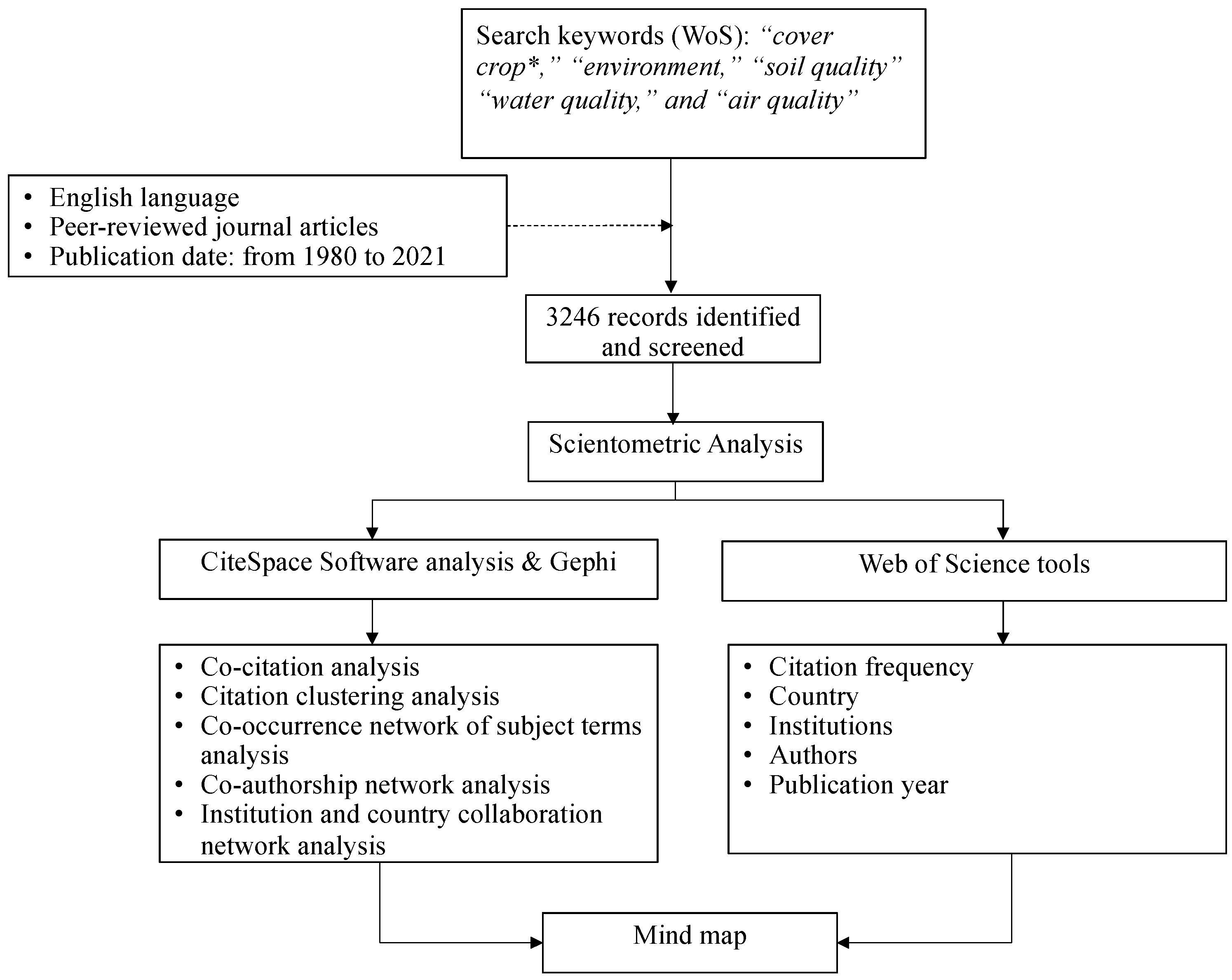
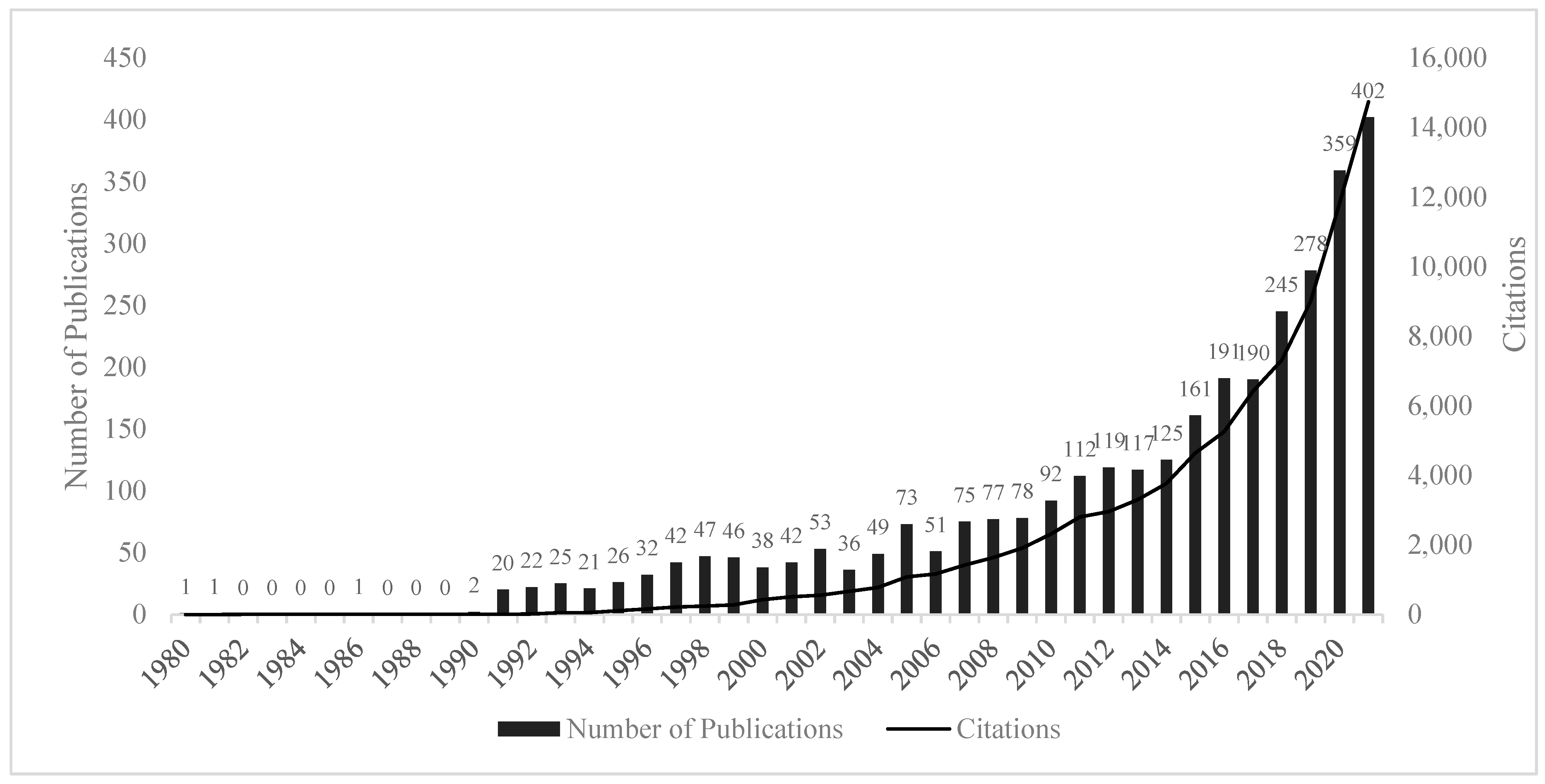
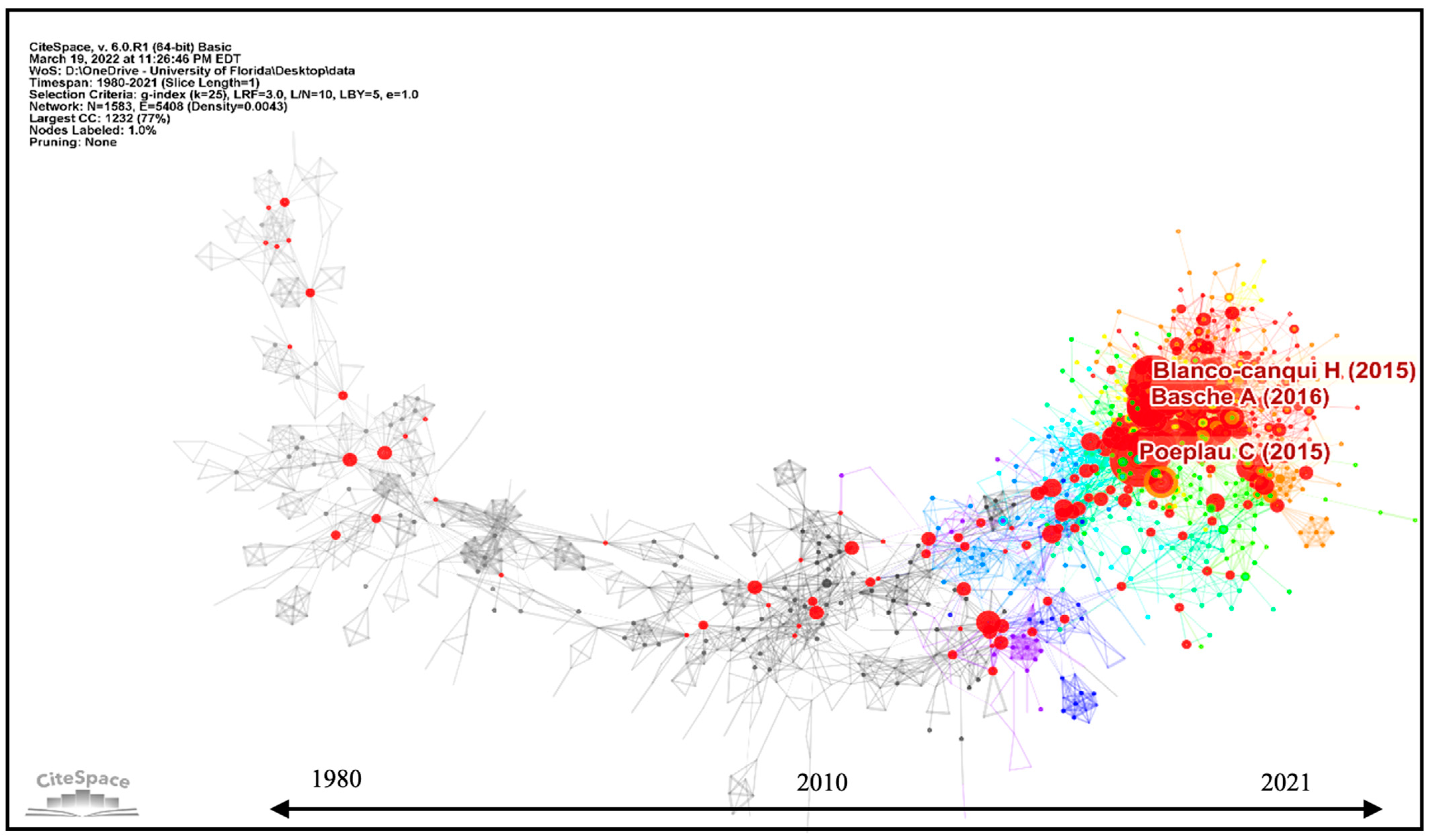
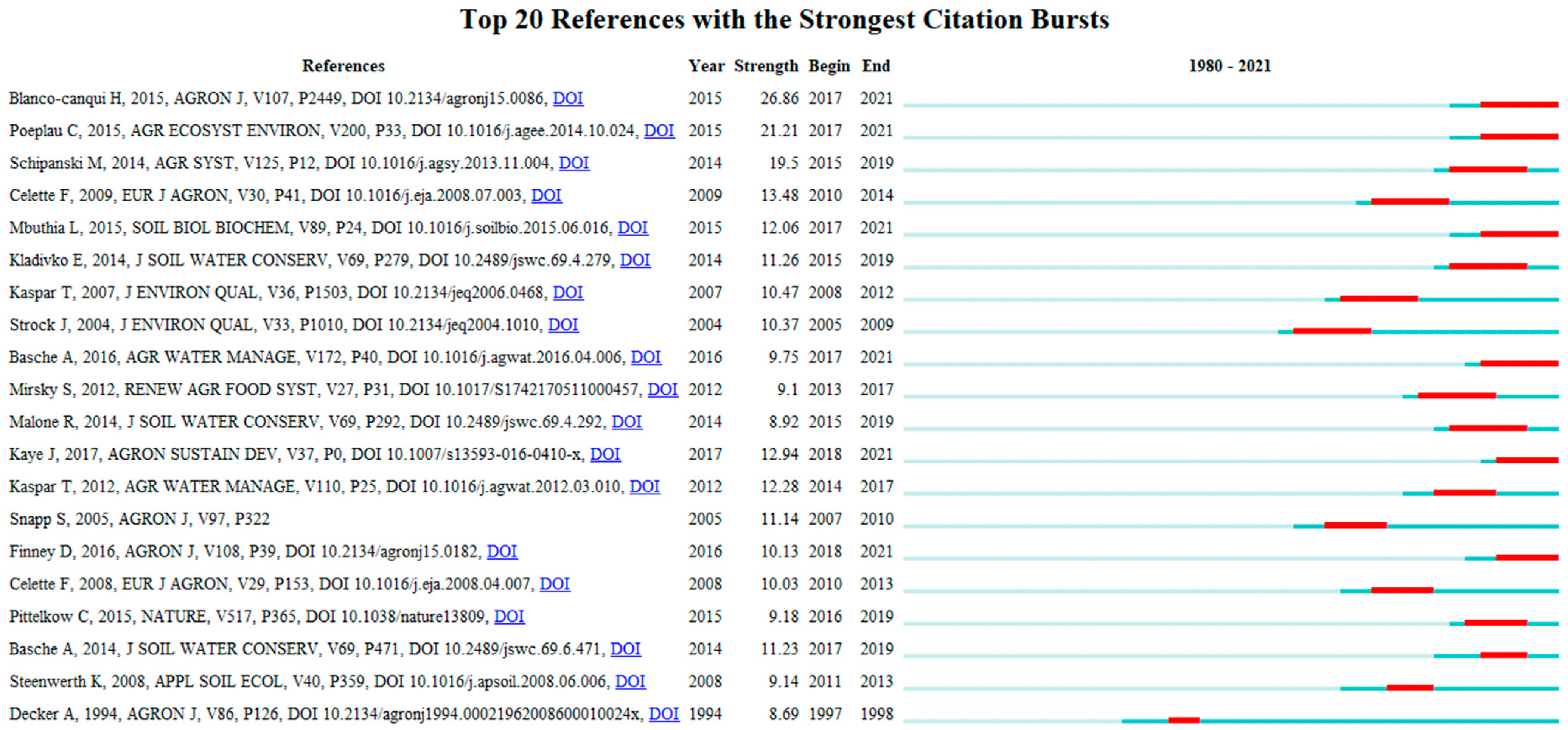

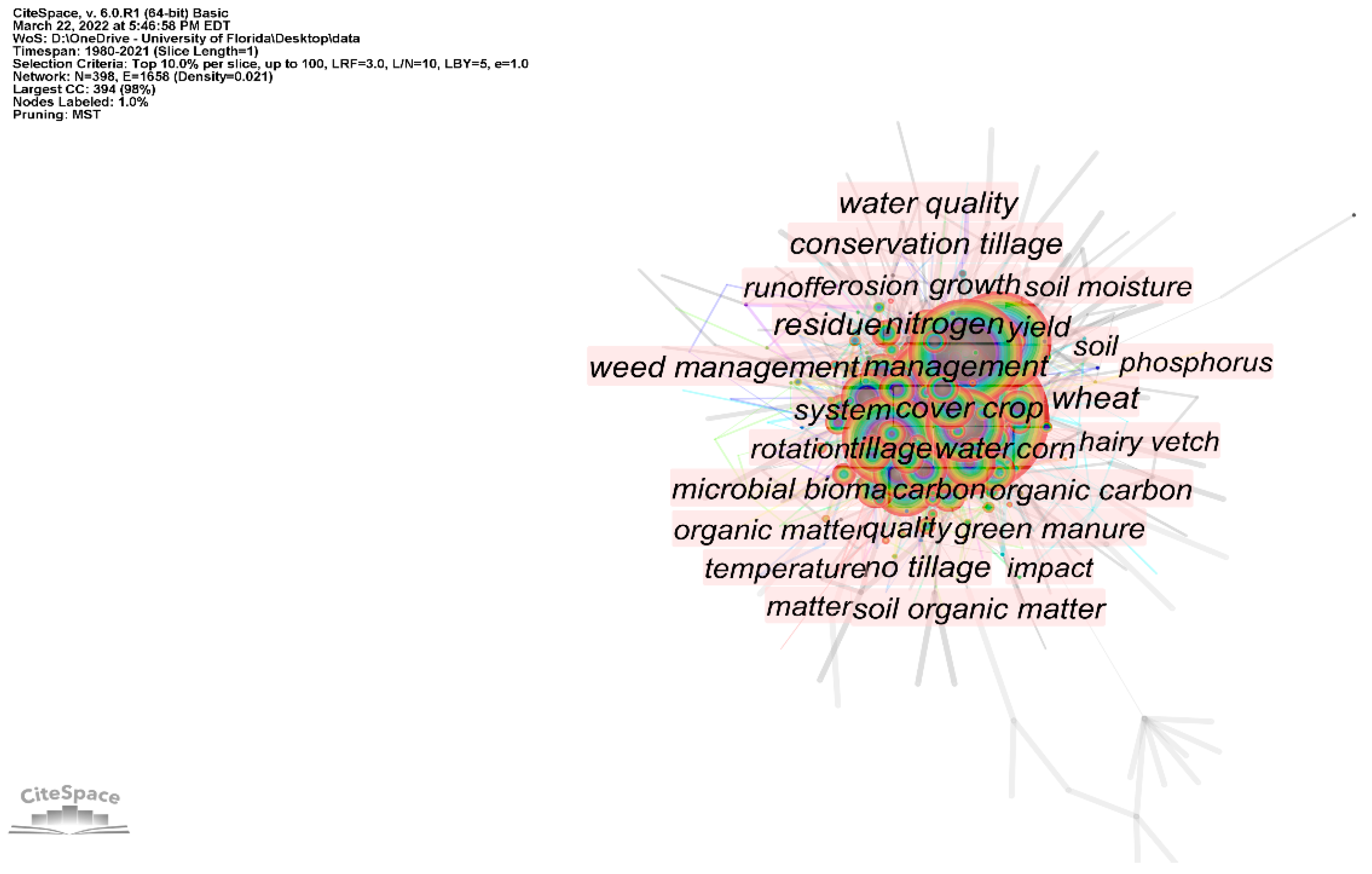

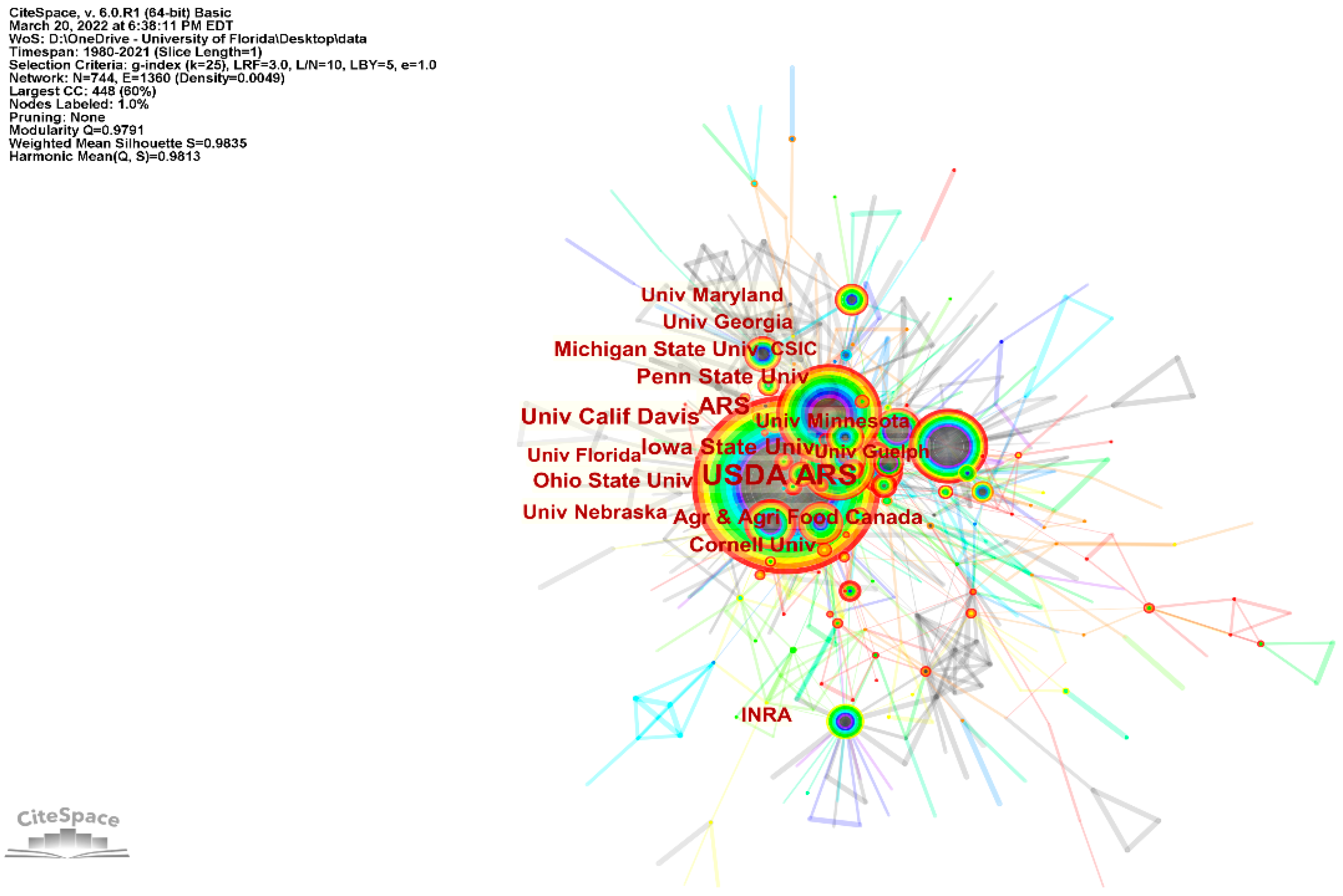

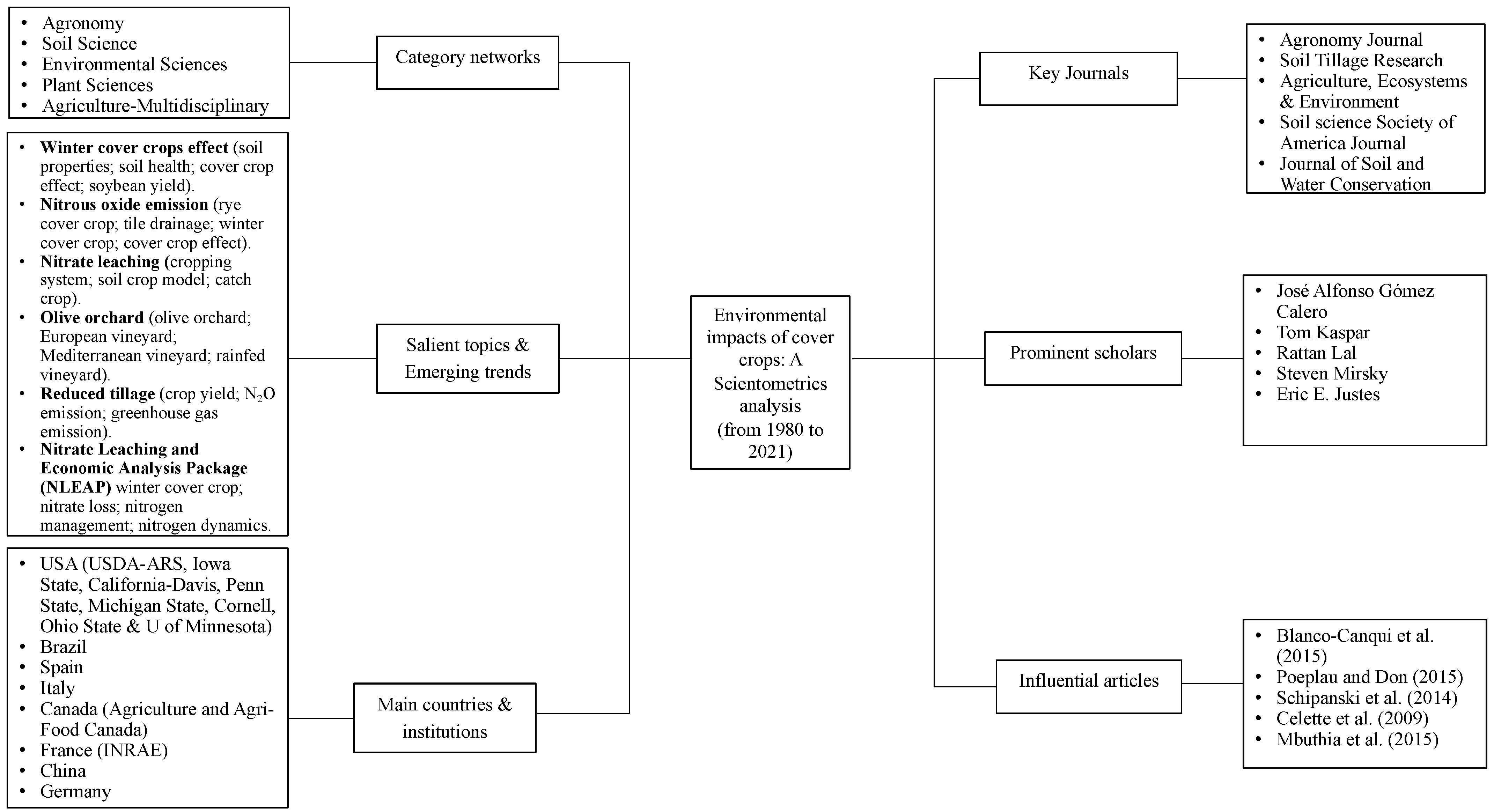
| Source | Web of Science Core Collection |
|---|---|
| Citation | Science Citation Expanded (SCIE) and Social Science Citation Index (SSCI) |
| Search Steps | TS = ((“cover crop*”) and ((environment) or (“soil quality”) or (“air quality”) or (“water quality”)) AND LANGUAGE (ENGLISH) AND DOCUMENT TYPES Article) |
| Time span | 1980–2021 |
| Qualified records | 3246 |
| Journal Name | Impact Factor | Number of Outputs | % |
|---|---|---|---|
| Agronomy Journal | 2.240 | 233 | 7.178 |
| Soil Tillage Research | 5.374 | 146 | 4.498 |
| Agriculture, Ecosystems & Environment | 5.567 | 130 | 4.005 |
| Soil science society of America Journal | 2.307 | 112 | 3.450 |
| Journal of Soil and Water Conservation | 2.330 | 107 | 3.296 |
| Journal of Environmental Quality | 2.751 | 76 | 2.341 |
| Agronomy | 3.417 | 76 | 2.341 |
| Plant and Soil | 4.192 | 68 | 2.095 |
| Agricultural Water Management | 4.516 | 62 | 1.910 |
| Field Crops Research | 5.224 | 59 | 1.818 |
| Subject | Publications | % |
|---|---|---|
| Agronomy | 999 | 30.776 |
| Soil Science | 953 | 29.359 |
| Environmental Sciences | 606 | 18.669 |
| Plant Sciences | 392 | 12.076 |
| Agriculture Multidisciplinary | 371 | 11.429 |
| Ecology | 323 | 9.951 |
| Water Resources | 311 | 9.581 |
| Horticulture | 179 | 5.514 |
| Agricultural Engineering | 91 | 2.803 |
| Geosciences Multidisciplinary | 79 | 2.434 |
| Authors | Title | Journal | DOI | Frequency |
|---|---|---|---|---|
| Blanco-canqui et al. (2015) [55] | Cover Crops and Ecosystem Services: Insights from Studies in Temperate Soils | Agronomy Journal | 10.2134/agronj15.0086 | 86 |
| Poeplau and Don (2015) [35] | Carbon sequestration in agricultural soils via cultivation of cover crops—A meta-analysis | Agriculture, Ecosystems & Environment | 10.1016/j.agee.2014.10.024 | 86 |
| Basche et al. (2016) [36] | Soil water improvements with the long-term use of a winter rye cover crop | Agricultural Water Management | 10.1016/j.agwat.2016.04.006 | 70 |
| Finney et al. (2016) [59] | Biomass Production and Carbon/Nitrogen Ratio Influence Ecosystem Services from Cover Crop Mixtures | Agronomy Journal | 10.2134/agronj15.0182 | 67 |
| Kaye and Quemada (2017) [34] | Using cover crops to mitigate and adapt to climate change. A review | Agronomy for Sustainable Development | 10.1007/s13593-016-0410-x | 67 |
| Schipanski et al. (2014) [58] | A framework for evaluating ecosystem services provided by cover crops in agroecosystems | Agricultural Systems | 10.1016/j.agsy.2013.11.004 | 50 |
| Basche et al. (2016) [60] | Simulating long-term impacts of cover crops and climate change on crop production and environmental outcomes in the Midwestern United States | Agriculture, Ecosystems & Environment | 10.1016/j.agee.2015.11.011 | 47 |
| Mbuthia et al. (2015) [61] | Long-term tillage, cover crop, and fertilization effects on microbial community structure, activity: Implications for soil quality | Soil Biology and Biochemistry | 10.1016/j.soilbio.2015.06.016 | 39 |
| Wittwer et al. (2017) [62] | Cover crops support ecological intensification of arable cropping systems | Scientific Reports | 10.1038/srep41911 | 38 |
| Pittelkow et al. (2015) [63] | Productivity limits and potentials of the principles of conservation agriculture | Nature | 10.1038/nature13809 | 35 |
| Cluster-ID | Cluster Label | Size | Silhouette | Year | Top 5 Terms (LSI) |
|---|---|---|---|---|---|
| #8 | Desiccated hairy vetch | 68 | 0.994 | 1990 | weed suppression; desiccated hairy vetch; hairy vetch residue; cover crop; herbicide replacement |
| #5 | NLEAP | 86 | 0.967 | 1994 | winter cover crop; nitrate loss; nitrogen management; NLEAP fact; nitrogen dynamics |
| #10 | Nitrogen fertilization | 52 | 0.963 | 1997 | nitrogen fertilization; fresh market tomato yield; soil nitrogen; physical properties; tillage intensity |
| #7 | Using winter cover crop | 70 | 0.973 | 1999 | carbon sequestration; nutrient cycle; west Asia; dryland ecosystem; north Africa |
| #11 | Tillage cover crop | 39 | 0.965 | 2001 | nitrogen fertilization; underlying soil; carbon accumulation; nitrogen fertilization effect; coastal plain field |
| #1 | Nitrous oxide emission | 119 | 0.880 | 2004 | nitrous oxide emission; rye cover crop; tile drainage; winter cover crop; cover crop effect |
| #15 | Olive grove | 13 | 0.993 | 2005 | olive grove; soil erosion; soil properties; soil management effect; southern Spain |
| #12 | Mulch-based cropping system | 30 | 0.970 | 2006 | cropping system; mulch-based cropping system; north Cameroon; mulching practice; multi-locational on-farm assessment |
| #6 | Microbiological function | 74 | 0.880 | 2007 | cover crop; microbiological function; water conservation dilemma; steep vineyard; green cover |
| #9 | Subtropical oxisol | 53 | 0.927 | 2009 | subtropical oxisol; Brazilian oxisol; organic agriculture; contrasting tillage system; crop-establishment period |
| #13 | Extractable carbon | 22 | 0.978 | 2008 | different cover crop residue; extractable carbon; microbial metabolic diversity; nitrogen pool; winter crop |
| #18 | Crops-alternative | 11 | 0.999 | 2010 | upland rice yield; no-tillage system; crops-alternative; upland rice development; cover crop |
| #2 | Nitrate leaching | 112 | 0.924 | 2011 | cover crop; cropping system; nitrate leaching; soil crop model; catch crop |
| #4 | Reduced tillage | 89 | 0.891 | 2013 | cover crop; crop yield; N2O emission; reduced tillage; greenhouse gas emission |
| #59 | Soil health indicator | 3 | 0.993 | 2014 | upland rice yield; no-tillage system; crops-alternative; upland rice development; cover crop |
| #3 | Oliver orchard | 104 | 0.934 | 2015 | cover crop; olive orchard; European vineyard; Mediterranean vineyard; rainfed vineyard; |
| #0 | Winter cover crops effect | 265 | 0.840 | 2016 | cover crop; soil properties; soil health; cover crop effect; soybean yield |
| #17 | Uruguayan vegetable | 12 | 0.978 | 2018 | soil microbiota; organic amendment; Uruguayan vegetable; farming system; soil health |
| Rank | Frequency | Degree Centrality | Betweenness Centrality | Closeness Centrality |
|---|---|---|---|---|
| 1 | Management (756) | Residue (39) | water quality (4575) | Nitrogen (0.426) |
| 2 | Nitrogen (475) | Nitrogen (38) | Weed Management (4567) | Management (0.423) |
| 3 | Yield (470) | wheat (38) | Quality (4199) | Wheat (0.418) |
| 4 | Tillage (439) | conservation tillage (36) | Germination (3976) | Carbon (0.417) |
| 5 | Soil (432) | Management (36) | Residue (3780) | Corn (0.416) |
| Author | Frequency | Degree Centrality | Betweenness Centrality | Closeness Centrality |
|---|---|---|---|---|
| José A. Gómez | 18 | 10 | 38.7 | 1.0 |
| Tom Kaspar | 16 | 15 | 916.4 | 1.0 |
| Rattan Lal | 16 | 2 | 1.0 | 1.0 |
| Steven Mirsky | 14 | 18 | 363.0 | 1.0 |
| Eric Justes | 14 | 6 | 166.0 | 1.0 |
| Institution | Frequency | Degree Centrality | Betweenness Centrality | Closeness Centrality |
|---|---|---|---|---|
| USDA ARS | 397 | 120 | 35,856.347 | 0.471 |
| Iowa State University | 107 | 51 | 5063.947 | 0.416 |
| University of California Davis | 96 | 41 | 9797.681 | 0.376 |
| The Pennsylvania State University | 74 | 27 | 7125.650 | 0.398 |
| Agriculture and Agri-Food Canada | 71 | 31 | 5403.697 | 0.379 |
| Michigan State University | 65 | 36 | 4899.075 | 0.395 |
| Cornell University | 64 | 33 | 9221.985 | 0.390 |
| Ohio State University | 61 | 25 | 3229.640 | 0.370 |
| University of Minnesota | 48 | 34 | 3709.021 | 0.39 |
| French National Institute for Agricultural Research | 53 | 28 | 8676.522 | 0.323 |
| Country | Frequency | Degree Centrality | Betweenness Centrality | Closeness Centrality |
|---|---|---|---|---|
| USA | 1608 | 87 | 3755.560 | 0.758 |
| Brazil | 236 | 25 | 144.465 | 0.541 |
| Spain | 203 | 35 | 461.344 | 0.565 |
| Italy | 179 | 32 | 165.041 | 0.543 |
| Canada | 177 | 21 | 85.837 | 0.518 |
| France | 149 | 41 | 565.124 | 0.584 |
| China | 145 | 29 | 246.070 | 0.548 |
| Germany | 112 | 49 | 691.823 | 0.610 |
| England | 83 | 36 | 304.888 | 0.568 |
| Australia | 74 | 32 | 654.972 | 0.556 |
Publisher’s Note: MDPI stays neutral with regard to jurisdictional claims in published maps and institutional affiliations. |
© 2022 by the authors. Licensee MDPI, Basel, Switzerland. This article is an open access article distributed under the terms and conditions of the Creative Commons Attribution (CC BY) license (https://creativecommons.org/licenses/by/4.0/).
Share and Cite
Liu, Y.; Ruiz-Menjivar, J.; Hu, Y.; Zavala, M.; Swisher, M.E. Knowledge Mapping of the Extant Literature on the Environmental Impacts of Using Cover Crops—A Scientometric Study. Environments 2022, 9, 120. https://doi.org/10.3390/environments9090120
Liu Y, Ruiz-Menjivar J, Hu Y, Zavala M, Swisher ME. Knowledge Mapping of the Extant Literature on the Environmental Impacts of Using Cover Crops—A Scientometric Study. Environments. 2022; 9(9):120. https://doi.org/10.3390/environments9090120
Chicago/Turabian StyleLiu, Yong, Jorge Ruiz-Menjivar, Yujie Hu, Monica Zavala, and Marilyn E. Swisher. 2022. "Knowledge Mapping of the Extant Literature on the Environmental Impacts of Using Cover Crops—A Scientometric Study" Environments 9, no. 9: 120. https://doi.org/10.3390/environments9090120
APA StyleLiu, Y., Ruiz-Menjivar, J., Hu, Y., Zavala, M., & Swisher, M. E. (2022). Knowledge Mapping of the Extant Literature on the Environmental Impacts of Using Cover Crops—A Scientometric Study. Environments, 9(9), 120. https://doi.org/10.3390/environments9090120








